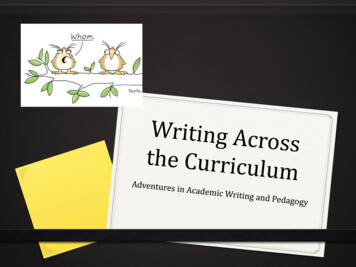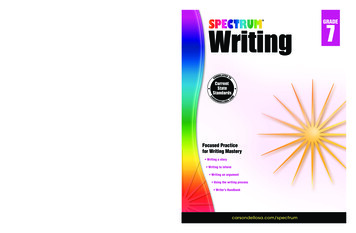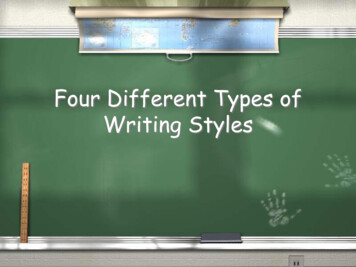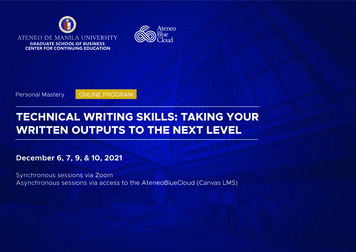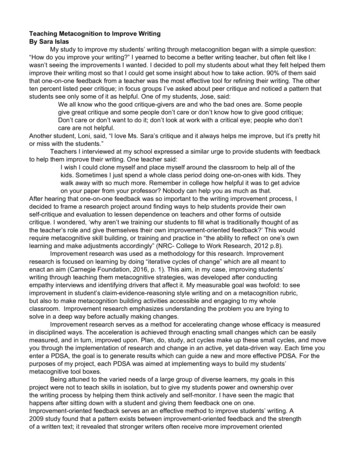
Transcription
Teaching Metacognition to Improve WritingBy Sara IslasMy study to improve my students’ writing through metacognition began with a simple question:“How do you improve your writing?” I yearned to become a better writing teacher, but often felt like Iwasn’t seeing the improvements I wanted. I decided to poll my students about what they felt helped themimprove their writing most so that I could get some insight about how to take action. 90% of them saidthat one on one feedback from a teacher was the most effective tool for refining their writing. The otherten percent listed peer critique; in focus groups I’ve asked about peer critique and noticed a pattern thatstudents see only some of it as helpful. One of my students, Jose, said:We all know who the good critique givers are and who the bad ones are. Some peoplegive great critique and some people don’t care or don’t know how to give good critique;Don’t care or don’t want to do it; don’t look at work with a critical eye; people who don’tcare are not helpful.Another student, Loni, said, “I love Ms. Sara’s critique and it always helps me improve, but it’s pretty hitor miss with the students.”Teachers I interviewed at my school expressed a similar urge to provide students with feedbackto help them improve their writing. One teacher said:I wish I could clone myself and place myself around the classroom to help all of thekids. Sometimes I just spend a whole class period doing one on ones with kids. Theywalk away with so much more. Remember in college how helpful it was to get adviceon your paper from your professor? Nobody can help you as much as that.After hearing that one on one feedback was so important to the writing improvement process, Idecided to frame a research project around finding ways to help students provide their ownself critique and evaluation to lessen dependence on teachers and other forms of outsidecritique. I wondered, ‘why aren’t we training our students to fill what is traditionally thought of asthe teacher’s role and give themselves their own improvement oriented feedback?’ This wouldrequire metacognitive skill building, or training and practice in “the ability to reflect on one’s ownlearning and make adjustments accordingly” (NRC College to Work Research, 2012 p.8).Improvement research was used as a methodology for this research. Improvementresearch is focused on learning by doing “iterative cycles of change” which are all meant toenact an aim (Carnegie Foundation, 2016, p. 1). This aim, in my case, improving students’writing through teaching them metacognitive strategies, was developed after conductingempathy interviews and identifying drivers that affect it. My measurable goal was twofold: to seeimprovement in student’s claim evidence reasoning style writing and on a metacognition rubric,but also to make metacognition building activities accessible and engaging to my wholeclassroom. Improvement research emphasizes understanding the problem you are trying tosolve in a deep way before actually making changes.Improvement research serves as a method for accelerating change whose efficacy is measuredin disciplined ways. The acceleration is achieved through enacting small changes which can be easilymeasured, and in turn, improved upon. Plan, do, study, act cycles make up these small cycles, and moveyou through the implementation of research and change in an active, yet data driven way. Each time youenter a PDSA, the goal is to generate results which can guide a new and more effective PDSA. For thepurposes of my project, each PDSA was aimed at implementing ways to build my students’metacognitive tool boxes.Being attuned to the varied needs of a large group of diverse learners, my goals in thisproject were not to teach skills in isolation, but to give my students power and ownership overthe writing process by helping them think actively and self monitor. I have seen the magic thathappens after sitting down with a student and giving them feedback one on one.Improvement oriented feedback serves an an effective method to improve students’ writing. A2009 study found that a pattern exists between improvement oriented feedback and the strengthof a written text; it revealed that stronger writers often receive more improvement oriented
feedback than weaker writers, illuminating the possibility of a vicious cycle that happens whenstudents are only getting evaluative or negative feedback (Dinnen, Collopy, 2009, p. 2). Onereason why improvement oriented feedback is so helpful in strengthening writing is that it helpswriters participate in the metacognitive process of monitoring their progress, identifying theirweak spots, and seeking out action plans to improve. Students need to hear and experience thekind of metacognitive feedback that will help them improve their work before beginning tointernalize and use it themselves.I wondered a lot about whether I could give students the skills to begin evaluating,comparing, and refining their own work. As a writing major in college, and after observingstudent writers, it has become apparent that successful writers are constantly thinkingmetacognitively about their work. Thus, I began working to help my students develop the abilityto be more metacognitive so they are able to monitor and revise along the way so that there isn'tas great a need for constant teacher and peer feedback. While many writers have been exposedto the writing process as something to move through, fewer students develop the metacognitiveskills to think about their thinking throughout the writing process; metacognition means studentsare taking time to plan, summarize, question, compare, restate, monitor, evaluate, and refinetheir writing in a recursive manner so that it's constantly transforming into a better version of theirwork.Strong writers actively and metacognitively involve themselves in the writing process by spendingmore time recursively planning and refining their writing (Graham & Harris, 1992; Hayes & Flower, 1986),by actively monitoring and adjusting the text they are generating (Beal, 1990; Beal et al., 1990), and bymaintaining an awareness of their audience (Bereiter & Scardamalia, 1987; Nystrand, 1986). In fact,strong writers embraces the writing process head on, understanding that it is “recursive rather thanconstrained and sequential” (1998, p. 2). The concept of writing as a process was introduced in the1980’s through the work of Donald Graves (1983) and the model proposed by Flower and Hayes (1980;1986). “Central to process writing is ‘ownership’ and ‘voice’ of the writer as connections are made andmeaning is constructed through the crafting of text” (Graves, 1994). Engagement is crucial to building upthe courage and desire to navigate the writing process as, “writers need to develop strong beliefs in therelevance and importance of writing and, as they grapple with writing’s complexities and frustrations,learn to be patient, persistent, and flexible” (2000, p. 2). In essence, strong writers are filling the role ofthe teacher or the peer that gives great critique, using metacognition to plan, monitor, and refine theirwriting as they go.In that case, why aren’t we training our students to fill what is traditionally thought of as theteacher’s role and give themselves their own improvement oriented feedback? This would requiremetacognitive skill building, or training and practice in “the ability to reflect on one’s own learning andmake adjustments accordingly” (NRC College to Work Research, 2012 p.8).The Case for MetacognitionMetacognition has become increasingly listed as a method for helping students become morestrategic and flexible writers. “An ability to monitor their processes might also help them to become morefully aware of the skills and strategies they are learning so that they may strategically apply them,” JamesPacello wrote in his study “Integrating Metacognition into a Developmental Reading and Writing Courseto Improve Skill Transfer,” (2010 p. 124). NRC also explained that metacognition can lead to deeperlearning (2012 p.8). Metacognition fits into several areas of deeper learning like critical thinking andproblem solving, self directed learning, communication, and self directed learning, as outlined by theHewlett Foundation; through metacognition students are able to engage in the deeper learning areas ofcritical thinking and problem solving because they can “find, evaluate, and synthesize information.”Additionally, metacognition can be seen as self directed in it’s nature. Depending on the piece of writing,students who naturally analyze their own work are able to more effectively communicate in their writingand oral constructs. Students who are able to evaluate their own work are more confident in it whichhelps them develop a more academic mindset.
Instruction in metacognition allows writers to understand how thinking about writing can improveone’s writing. Metacognition can help give students skills to me more active learners; “it is the controlprocesses which active learners engage in as they perform various cognitive activities” (Raphael et al,1989, p. 346). Metacognition makes all learning deliberate because learners are conscious of their owncognitive processes, their strengths, and their needs (Flavell, 1976); they are constantly checking andcounter checking their understanding. Metacognitive learners ability to monitor their learning allows themto acknowledge when they don’t understand something and go back over the content until they do. Nistand Simpson (2000) stated that many students lack metacognitive skills and opportunities to practicethem. However, they found that students can be supported to strengthen their reflection and monitoringskills.Jose’s point that “we all know who the good critique givers are and who the bad ones are” mirrorsa larger trend around metacognition: students who have strong metacognitive abilities are able to critiquetheir work and improve upon it while students who lack these skills are left to rely on the help of a teacheror peer with strong metacognitive skills if their work is to be improved (Rainville, 1996). ErnestHemingway has talked extensively about how “writing is rewriting.” In my classroom, students who laborover the planning, evaluation, and revision process are students who end up with high quality work.Thus, how can we expect our students to improve their writing if we are teaching skills in isolation ofmetacognition?Teaching writing should be teaching metacognition at the same time. In Tanya Santangelo’sarticle Why is Writing So Difficult for Students with Learning Disabilities? A Narrative Review to Informthe Design of Effective Instruction (2014) she writes that writing instruction should promote and facilitatetargeted and personalized interventions to help promote writing competency; students who struggle withthe writing process benefit from strategies to meet their needs, while students who lack experience withthe styles of different models, while students who don’t enjoy writing need support finding the value in it(p. 17). Because students run the gamut when it comes to their writing needs, and because writing is askills that cannot one can never finish learning, differentiation is key. L earning my students self reportedwriting levels, and that only 30% of writers score proficient on state tests nationally ( Applebee andLanger (2011) , my desire to improve my writing instruction practice grew immensely. In a classroomsurvey I gave, 60% of my students rated themselves as “emerging” writers while 10% listed themselvesas “needs support,” 20% as “satisfactory,” and “10%” as “exceeding.”Santangelo, Hayes and Flower, and Graham all argue that students really learn how to write afterthey understand and utilize an emboldened form of the writing process, a practice any writer can engagein at any level. B.M Sitko (1998) found that in order to engage students in the decision making processesnecessary to effectively work through the writing process, students must be provided instruction inmetacognition (p. 1). The ability to “monitor learning success” (Weinstein, Acee, & Jung, 2011, p. 47) is acrucial dimension of metacognition. Such monitoring can assist students to become more attuned towhich skills and strategies help them succeed in different contexts so that they are able to apply themwhen appropriate; it can also help them identify what part of the writing process they are struggling withso that can seek support in those areas specifically (Weinstein et al., 2011).Explicitly teaching students how to use metacognitive strategies like self reviewing, questioning,clarifying, and making predictions, makes it possible for students to enhance and automate theirmetacognitive skills (p. 1). Paliscar and Brown (1986) found that students could enhance their ability tomonitor their own thinking through learning how to use basic metacognitive skills and being reminded touse them (p. 771). In their study, “How an Understanding of Cognition and Metacognition translates intoMore Effective Writing Instruction,” O’Brien Moran and Soiferman (2010) wrote that utilizingmetacognitive skills actually frees writers up to focus on other elements of the writing process: “oncemetacognitive strategies become automatic students are able to devote more of their working memory tothe hierarchical stages of writing involving planning, generating, and reviewing” (p. 1).When instruction comes with an emphasis on fostering metacognitive development in students,students become more active learners (Caverly, Nicholson, & Radcliffe, 2004; El Hindi, 1997). A studentaware of the metacognitive area is said to be able to monitor the cognitive decisions that he or she
makes and assess the effectiveness of such decisions (Thiede, 2002). For example, while writing, astudent can monitor how effectively he or she is addressing the prompt. To be a strong writer, it isessential to not only possess knowledge regarding writing style and structure, but also to possess theability to continually reassess one’s choices as a writer. Students need to be provided with many opportunities to reflect on the skills and strategies they are learning so that they can become moreconscious of how those skills and strategies could be used beyond the classroom. Metacognition createsan avenue for all levels of writers to improve by monitoring their learning in order to seek out skills andstrategies to improve upon their weaknesses and opportunities to utilize their strengths.Ambrose et. al suggest that teaching students metacognition can help them become moreself directed learners. “Metacognitive interventions may be an especially powerful tool in helping the“academically adrift” student find a way to get into the game, to become more aware of the kind ofthinking that supports strong academic performance” (Ottenhoff, Liberal Education). In addition to writingimprovement, metacognition can span content areas and college preparation skills. Engagement is keyto learning, whether it’s writing or math; “research shows that the more actively engaged studentsare with college faculty and staff, with other students, and with the subject matter they study the morelikely they are to learn, to stick with their studies, and to attain their academic goals” (Community CollegeSurvey of Student Engagement, 2006, as cited in McGlynn, p. 106).Site and participantsHigh Tech High Chula Vista is a project based learning school in Chula Vista, California thatwhere teachers and students strive to connect to their community and environment, and the worldoutside their classroom. Personalization, equity, empowerment, engagement, and student voice are atthe center of every teacher’s practice. Teaching teams composed of two classes in different subjects(often science and humanities classes) are paired together and share a set of around 60 students.Teaching teams often integrate subjects to create complex, real world projects for students to engage in.High Tech High Chula Vista opened in 2007 and has grown from 150 students to over 600. Ourstudents, who are admitted through a randomized lottery system, represent every community in theSouth Bay and many other areas of San Diego. High Tech High Chula Vista is a Title 1 school, with over51% of our students qualifying for free and reduced lunch.Our school is full inclusion; 12% of our population has an Individualized Education Program (IEP).On our 9th grade teaching team (which is an integration of physics and humanities), we have ninestudents with IEPs. We have two students that qualify as English Language Learners, while 7% of ourschool’s students in total qualify as English Language Learners. 64% of my students are Hispanic, 14%are Asian, 10% are Caucasian, 6% are African American, 5% are Native American, and 1% are PacificIslander. 40% of my students have a reading level below grade level, and 20% of my students are threeor more levels below grade level based on the Star Reader Test.A Shift to Metacognitive Instruction in the ClassroomIn my effort to find out how I could best engage writers in accessible metacognitive activitiesthat translated into the improvement of their writing, I sought out a variety of ways to makemetacognition instruction fun, playful, and collaborative. Throughout my study, I continually designednew ways to help my students embed metacognition into the writing process. In my data collection ofstudent work and interviews from focus groups, I coded for how often different the followingmetacognitive skills were mentioned, explicitly or implicitly. Based on O’Brien Moran & Soiferman’sideas about how training in metacognition allows novice writers to begin to understand the effects thatthinking about writing has on the writing process my main goal in data collection became seeingwhether or not the explicit instruction and heightened focus on metacognition was was becoming apart of my students writing process. I emphasized the following areas of metacognition which are all
surrounding process, because Santangelo, Hayes and Flowers, and Graham all argue that studentsreally learn how to write after they understand and utilize an emboldened form of the writing process.Negretti also further supports focusing on metacognition around process through her ideas that anawareness of one’s language choices combined with a heightened disposition to overtly thinking aboutone’s writing process, consequently, should result in a greater ability to self regulate and self evaluatethroughout the writing process (Negretti, 2010, 2012). I derived the following process orientedmetacognitive from a collection of important metacognitive skills listed by El Hindi (1997), Gourgey(2003), Laverpool (2008) in their writing. Planning: are you making a plan or outline of what you are going to write and whatevidence you need to collect?Summarizing: are you going over what you just wrote and making sure it says whatyou want it to say?Questioning: are you asking questions about what you’ve written (does it makesense? does it sound too wordy?)?Comparing: are you looking at models and comparing your work to it?Restating: are you writing it out in a different way or using different phrasing andseeing if it sounds better?Monitoring: are you looking over your progress and making sure you are where youneed to be/making a plan to get where you need to be?Refining: are you seeking out critique and critiquing yourself and then making neededchanges?Evaluating: are you asking yourself whether or not your work meets the requirementsand is high quality?To better understand the effects of my newly implemented instruction of metacognition, I createda focus group of students with whom I would conduct interviews and examine their writing. This groupwas made up of eight students; six of the students were girls and two of the students were boys. Four ofthe students have identified as emerging writers, two of students have identified as satisfactory writers,and two of the students rated themselves as exceeding writers; it was important to me to have a mixedgroup of writing levels. All students are students of color. In the 9th grade, we work on a specific style ofwriting called Claim, Evidence, Reasoning. Students often turn in writing pieces in this format. I hadstudents assess their writing on a 1 4 scale based on the following explanations:Writing Score Rubric1: Not Meeting Goal: Forgets or is ineffective in two or more elements of the Claim, Evidence,Reasoning format.2: Approaching Goal: Forgets or is ineffective in no more than one element of the Claim, Evidence,Reasoning format.3: Meets Goal: Presents a claim that can be argued for or against, uses evidence relevant to the claim,and explains the evidence using reasoning.4: Exceeds Goal: Presents a very specific claim that can be argued for or against, uses evidence thatsupports the claim, and explains the evidence using reasoning and addresses a counterargument.Metacognition Score Rubric1: Little to No Use of Metacognition
2: Use of Metacognition3: Effective Use of Metacognition in Most Phases4: Effective Use of Metacognition in all PhasesBaseline Data:After students rated their writing, I asked them to explain why they gave the score they did. Themajority of students gave themselves a score of 2 and explained that it was because they did not haveenough evidence to support their claims. This showed me that I needed to scaffold an activity around themetacognition behind finding and evaluating evidence, which turned into a change idea. Next, studentsexplained they gave themselves a low rating because they didn’t understand understood the materialthey were writing about in the first place. This pushed me to design a change idea about monitoring yourunderstanding and developing research questions and another about monitoring your progress with apartner. I noticed another pattern around critique. Many students felt like they were not given helpfulcritique so I decided to create a change idea to help students give very specific critique, where studentsare not necessarily giving feedback, but noticing and annotating. I also noticed that a lot of students feltlike they were having style and wording problems, which inspired a change idea around studentscollaboratively restating each other's’ writing.The next baseline data I took was focused on a metacognition rubric. I read through andexplained the rubric and then answered questions using specific examples. The sections of this rubricasked students to rate whether they were “using effectively,” “using but needing support,” or “notapplying” the following metacognitive methods: planning, summarizing, questioning, comparing,restating, monitoring, refining, and evaluating. The data showed that most students were not applying orneeding support around all of them, with a high need around planning, restating, refining, and evaluating.This was interesting to me because I felt like these were metacognitive parts of the writing process thatwere most vital, as well as most challenging and time consuming. For the duration of my study (about3 4 months) I implemented change ideas to support metacognitive habit forming in my classroom.Below is the end data, which shows where students ranked their writing and use of metacognitionat the end of the study:
A trend I’m seeing is that the writers who are scoring themselves higher and getting higher scoreson both their writing quality and in metacognition are also able to name metacognitive skills and how theyare used in their writing. Kiley, for example went from a one in metacognition to a two. She was able toexplain how she was increasing her use of metacognition:I’m using a lot more evidence and thinking what could they argue back? Whatcould the counterargument be? I plan in advance. Choosing the right word and restatinguntil you get it is really important too.Sam, for example, did not name any metacognitive skills while discussing his growth. He wasvery much focused on writing the correct amount of pages, even though there was not a required pageminimum. He was also focused on using the writing skill goal (sensory detail) to improve his writing, butnot focused on integrating the metacognitive skills he was using. He said, “before I wouldn’t use sensorydetails or a lot of examples wouldn’t write enough as required. Now I write a lot.” My hunch is that Samwas giving his attention to what he thought was getting assessed, when in reality, what was gettingassessed was the efficacy of his ability to communicate his points clearly through writing and back themup with evidence.Max, who did not show growth in metacognition displayed that he was not being metacognitive,but instead relying on help from others to improve his work. He said, “I think the improvement planshelp,” which makes sense because these are done collaboratively and I noticed he was relying on hispeer’s feedback to create his plan. He also said, “Also, critique is really good. I still don’t feel like I’mgood at critique.” This struck me because in order to be metacognitive you need to be able to evaluateyour own work. If Max was not able to evaluate his own work, it makes sense he was still feeling that itwas a stretch to evaluate others’.RecommendationsI found two effective approaches to support the instruction of metacognition for writing. First, Ifound that planning writing instruction with a framework that involves play and collaboration helpsstudents engage in metacognition more effectively. Second, I found that common language used acrosswriting genres can help simplify the metacognitive process.A New FrameworkMy original goal was to infuse instruction of metacognition into my teaching and see if it made animpact in my students’ writing. After confirming that strong metacognitive skills can be applied to improvewriting, I realized that I needed to find ways to intertwine metacognition into the class in an engagingway. This came after my first focus group meeting. Loni, a student whose writing was self and teacherevaluated to be as 4, or accurately representing what she intended to say, and whose metacognitive
skills were ranked as “using effectively,” was able to explain the metacognitive skills she was gaining andwhy they were helpful to her. She said:I feel like I’ve taken in a lot of the metacognitive skills and just realized, like that’swhat it is to be a good writer. Anyone can do it. If you read over your work with acritical eye, read it all out loud, make improvement plans, and actually make thosechanges, it’s going to get better. The people that do that have great work.Another student, Sam, whose writing was self and teacher evaluated as “emerging” and whosemetacognitive skills were ranked as “not using” was not able to explain metacognition or why it might notbe helpful. However, what he was able to do was name activities I had used to teach metacognition. Theactivities he named all involved play and collaboration.Metacognition I don’t know what it is ( Interviewer gives reminder ofspecific metacognitive play strategy used in class) Oh, when you make us readour final draft aloud in an English accent to each other? Yeah, that is helpfulbecause it’s funny and it forces you to hear your mistakes and the other personcould catch them if they are listening. Then you can refine.Sam was explaining the important metacognitive skill of refinement, which we tackled in aplay based, collaborative way in class. As soon as Sam mentioned the activities, the other students inthe focus group lit up and started mentioning how helpful those activities were. They did not mention theindividual reflection activities we did. Below is a list of the collaboration and play infused activities we didto build metacognition with samples of student writing and student quotes about how they felt it helpedimprove their writing. See appendices for a list of the metacognitive strategies that were used in myclassroom.Looking at an example of student work transformed through metacognitive activities:In looking at their own writing, students were able to explain the metacognitive activities thathelped them improve their work. Below is Elli’s thesis, which she improved using several of the activitiesabove.Here is Elli’s original thesis about the impact of the Industrial Revolution: The Industrial Revolution changed the relationship between humans and their environment .After the sentence puzzle activity which students compared Elli’s work to a model, she realized:“it was not specific enough. The puzzle we picked apart was really specific. The idea was there but I wasnot saying what exactly happened.During the Industrial Revolution manual labor was replaced by machinery, causing an increasein factories.After the 3rd grade, 9th grade, college level activity, Elli realized she could add more of asignificance to her thesis: “the college level was supposed to answer ‘so what?’ so I made sure to addthat.During the Industrial Revolution manual labor was replaced by machinery, causing an increasein factories for the crowded population and making a large amount of coal pollution and waste thataffects our health today.After the restating activity, Elli’s peers gave her many ideas: “I could use a semicolon so I couldattach two thoughts, I could mention the word surplus to show cause and effect, and I could make thelast part of my sentence a parallel so it felt more organized.” Below is her final thesis:
During the Industrial Revolution manual labor was replaced by machinery; this created asurplus of workers amongst an already crowded population and caused us to use a huge amount ofcoal which causes pollution and waste that continues to affect our health today.This student example and many others provided evidence that my students were exposed tometacognition by being able to access to activities that were scaffolded to their level. Often, I saw thegatek
Plan, do, study, act cycles make up these small cycles, and move you through the implementation of research and change in an active, yet data driven way. . project were not to teach skills in isolation, but to give my students power and ownership over the writing process by helping them think actively and self monitor. .






